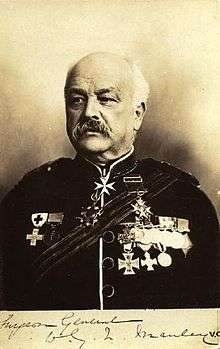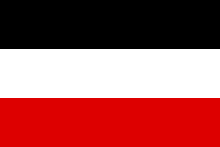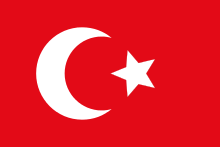William Manley
| William Manley | |
|---|---|
 | |
| Born |
17 December 1831 Dublin, Ireland |
| Died |
16 November 1901 (aged 69) Cheltenham, Gloucestershire, England |
| Allegiance | United Kingdom |
| Service/branch | British Army |
| Rank | Surgeon General |
| Unit |
Royal Regiment of Artillery Royal Army Medical Corps |
| Battles/wars |
Crimean War New Zealand Land Wars Franco-Prussian War Second Anglo-Afghan War Anglo-Egyptian War |
| Awards |
Victoria Cross Companion of the Order of the Bath Iron Cross, 2nd Class (Prussia) |
Surgeon General William George Nicholas Manley, VC, CB (17 December 1831 – 16 November 1901) was a British Army officer, surgeon and a recipient of the Victoria Cross, the highest award for gallantry in the face of the enemy that can be awarded to British and Commonwealth forces. He might be the only man to have been awarded both the VC and the Iron Cross.
Early life
Manley was born in Dublin, Ireland, on 17 December 1831, the second son of the Reverend William Nicholas Manley, his mother being a daughter of Dr. Brown of the Army Medical Staff. He was educated at the Blackheath Proprietary School and became a member of the Royal College of Surgeons of England in 1851.[1]
Military career
In 1854 Manley joined the Army Medical Staff, and was attached to the Royal Regiment of Artillery serving in Crimea. He was present for the Siege of Sevastopol during the Crimean War. He was later posted with his regiment in New Zealand.[1]
Victoria Cross
Manley was 32 years old, and an assistant surgeon in the Royal Regiment of Artillery during the Waikato-Hauhau Maori War, New Zealand when the following deed took place on 29 April 1864 near Tauranga, New Zealand, during the assault on the rebel pā ("pah") Gate Pā, for which he was awarded the VC.
For his conduct during the assault on the Rebel Pah, near Tauranga, New Zealand, on the 29th of April last, in most nobly risking his own life, according to the testimony of Commodore Sir William Wiseman, Bart., C.B., in his endeavour to save that of the late Commander Hay, of the Royal Navy, and others.Having volunteered to accompany the storming party into the Pah, he attended on that Officer when he was carried away, mortally wounded, and then volunteered to return, in order to see if he could find any more wounded. It is stated that he was one of the last Officers to leave the Pah.[2]
He also served in the same war under Sir Trevor Chute, and was present at the assault and capture of the Okotukou, Putahi, Otapawe, and Waikohou Pahs. For his services on these occasions he was again mentioned in dispatches and promoted to staff surgeon.[1]
Later career
When the Franco-Prussian War broke out in 1870 he proceeded with the British ambulance corps, and was attached to the 22nd division of the Prussian Army. He was present for several battles, and received several decorations including the Iron Cross (second class) on the recommendation of the German Crown Prince:
For services with the British Ambulance Corps caring for the wounded of the 22nd Division in the actions of Chateau-neuf and Bretoncelle, on 18th and 21st December 1870, and the battles of Orleans and Cravant, on 10th December 1870.[1]
In 1878–79 he served with the Quetta Field force in the Second Anglo-Afghan War, and in 1882 he was in Egypt for the Anglo-Egyptian War as Principal Medical officer of the Second Division under Sir Edward Hamley and was present at the Battle of Tel el-Kebir. After this war he was promoted to Deputy Surgeon-General.[1]
Later life
Manley was awarded the honorary rank of surgeon general and retired from the army in 1884 with a distinguished service pension. Upon retirement he was made a Knight of the Venerable Order of Saint John of Jerusalem and a Companion of the Order of the Bath. He died in Cheltenham, Gloucestershire, on 16 November 1901.[3]
Family
Manley was married to Miss M. E. Darton, daughter of Thomas Hartwood Darton, of Temple Dinsley, Hertfordshire. They had one daughter and five sons, including Lieutenant G. E. D. Manley, who died while on service in China shortly before his father´s death in 1901.[1]
Honours and Awards

Manley earned himself 18 medals, including the most prestigious medals of the United Kingdom, Imperial Germany, France, and Afghanistan. He is possibly the only recipient of both the VC and the Iron Cross.
Among his awards were:[1]
-
 United Kingdom Crimea Medal – 1855
United Kingdom Crimea Medal – 1855 -
 United Kingdom Victoria Cross – September 1864[2]
United Kingdom Victoria Cross – September 1864[2] -
 United Kingdom Afghanistan Medal – 1879
United Kingdom Afghanistan Medal – 1879 -
 United Kingdom Egypt Medal and clasps – 1882
United Kingdom Egypt Medal and clasps – 1882 -
 United Kingdom Companion of the Order of the Bath (CB) – 1894
United Kingdom Companion of the Order of the Bath (CB) – 1894 -
.svg.png) Kingdom of Prussia Iron Cross – 1871[4]
Kingdom of Prussia Iron Cross – 1871[4] -
 German Empire War Commemorative Medal of 1870/71 (steel) – 1871
German Empire War Commemorative Medal of 1870/71 (steel) – 1871 -
.svg.png) Kingdom of Bavaria Military Merit Order 1871
Kingdom of Bavaria Military Merit Order 1871 -
 Ottoman Empire Order of Osmanieh (third class) – 1880s
Ottoman Empire Order of Osmanieh (third class) – 1880s -
 Khedivate of Egypt Khedive's Star – 1880s
Khedivate of Egypt Khedive's Star – 1880s
During his time in New Zealand he also received the bronze medal of the Royal Humane Society for rescuing a man from drowning, and after the siege of Paris he received the Cross of the Société française de secours aux blessés militaires.[1] [5]
His medals are on display in the medals gallery of Firepower - The Royal Artillery Museum in Woolwich, south east London.
References
Citations
- 1 2 3 4 5 6 7 8 "Obituary – Surgeon-General Manley". The Times (36616). 19 November 1901. p. 6.
- 1 2 London Gazette (22896). 23 September 1864. p. 4552. Missing or empty
|title=(help); - ↑ "William George Nicholas Manley, C.B., V.C., M.R.C.S. Eng". The Lancet. 2: 1459. 23 November 1901.
- ↑ "Obituary: Surgeon-General W.G.N. Manley, V.C.". London Medical Press and Circular. 123: 584–585. 1901-11-27.
- ↑ Wilkins, Philip Aveling (1904). The History of the Victoria Cross. A. Constable. pp. 190–191.
General References
-
 Power, D'Arcy (1912). "Manley, William George Nicholas". In Lee, Sidney. Dictionary of National Biography, 1912 supplement. London: Smith, Elder & Co.
Power, D'Arcy (1912). "Manley, William George Nicholas". In Lee, Sidney. Dictionary of National Biography, 1912 supplement. London: Smith, Elder & Co. - D'A. Power, rev. Bertrand O. Taithe. "Manley, William George Nicholas (1831–1901)". Oxford Dictionary of National Biography (online ed.). Oxford University Press. doi:10.1093/ref:odnb/34850. (Subscription or UK public library membership required.)
- The Register of the Victoria Cross (1981, 1988 and 1997)
- Clarke, Brian D. H. (1986). "A register of awards to Irish-born officers and men". The Irish Sword. XVI (64): 185–287.
- Ireland's VCs, Dept of Economic Development, 1995, ISBN 1-899243-00-3
- Monuments to Courage, David Harvey, 1999
- Doherty, Richard; Truesdale, David (2000). Irish Winners of the Victoria Cross. Four Courts. ISBN 9781851824915.
External links
- Location of grave and VC medal (Gloucestershire)